Samsung Galaxy Note20 Ultra 5G review
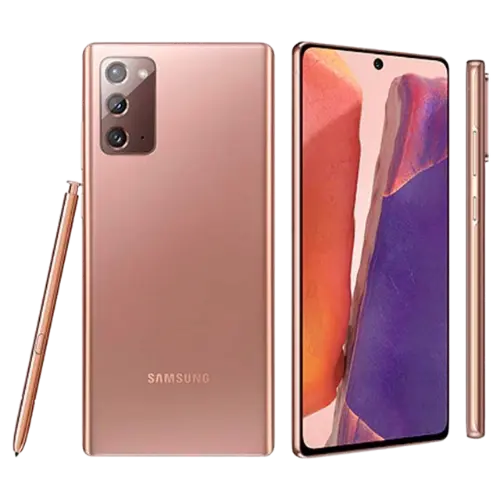
-
- Battery Score
3.5
- Camera Score
4.5
- Design Score
4
- Performance Score
4
- Battery Score
3.5
Summary
Quick verdict: The Galaxy Note20 Ultra brings great cameras and fast performance, but for most folks the regular Note20 may be the smarter option.
- Camera is fast and accurate
- S-Pen is a great productivity tool
- 120Hz display can be lovely to look at
- Water resistance
- Battery life at 120Hz is sub-par
- 50x Space Zoom delivers awful pictures
- Chunky camera bump
Details
Pricing & Availability
| Launch price (RRP) | $1,999 |
| Launch date | 2020-08 |
Outside of folding phones, Samsung's process for phone development has followed a very predictable schedule. Early in the year you get the big new features in the Galaxy S flagship phones, and later on, they're lightly refined and applied to large screen, stylus-equipped phones in the Galaxy Note lines.
That's precisely what Samsung has done with the Samsung Galaxy Note20 Ultra and Samsung Galaxy Note20 Ultra 5G phones, albeit with a few tweaks in terms of colour choices and camera specifications. The Galaxy Note20 Ultra 5G sits at the pinnacle of Samsung's current flagship phone tree, at least until the Galaxy Z Fold 2 breaks cover more formally in early September 2020. However, it's also counterpointed by the smaller and cheaper Galaxy Note if it is S-Pen use you crave, not to mention the vast array of very good mid-range phones we've seen emerge this year, including several in the Samsung Galaxy A series.
The heat is on the Galaxy Note20 Ultra 5G to justify its high grade asking price beyond simple specifications. It mostly does that, but for many folks, even those who have traditionally loved the Note series, it's hard not to see the regular Note20 as the smarter buy.
Design
Design
- 6.9-inch Dynamic AMOLED display
- You can have full resolution or 120Hz – but not both
- Enormous camera bump
- Great in-display fingerprint reader
- Three colour styles
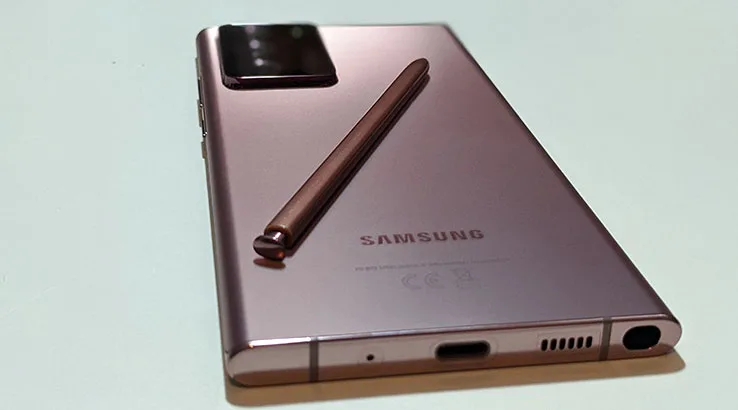
The Galaxy Note20 Ultra 5G definitely lives up to the Note promise of providing a large display, because nobody's going to call a phone with a 6.9-inch 3,088x1,440 pixel Dynamic AMOLED display "small" any time soon. It's a lot of phone to hold in your hand, and you'll need decent sized mitts to simply grasp it, given its 164.8x77.2x8.1mm size.
All of the new Note phones are apparently magical, or at least they come in "mystical" colours. In the case of the Galaxy Note20 Ultra 5G that's Mystic Black, Mystic White or Mystic Bronze. They're not actually capable of telling your fortune or connecting you to the voices of the dead – that's a plus, right? – but are instead a metallic black, white or rose gold finish.
It's the latter that I've tested, and it's easily the most extroverted of the Note20 colours. I'm not usually a fan of rose gold finished phones, but there's definitely something about the Galaxy Note20 Ultra 5G's finish that speaks to its premium price point.
The display on the Galaxy Note20 Ultra 5G has a slight design tweak over that of the regular Note20, with a smaller holepunch array for its front-facing camera. Side by side it's noticeable, but it's not a factor I'd buy the Galaxy Note20 Ultra 5G for specifically.
What might tempt you more in a screen sense is the inclusion of 120Hz refresh rates for the display, a feature it's inherited from the Galaxy S20 Ultra. What it's also inherited from its slightly older sibling is a limitation in the way that 120Hz display works.
While the Dynamic AMOLED on the Galaxy Note20 Ultra 5G has a 3,088x1,440 pixel resolution, if you want to use each and every one of those dots, you're stuck in plain 60Hz mode.
To enable 120Hz, you've got to drop it down to FHD+ (2,316x1,080) resolution to do so. Even then, you get what Samsung calls an "Adaptive" display which can scale up to 120Hz depending on your content choice. 120Hz is pretty sweet for fast scrolling, but you won't always see it on the Galaxy Note20 Ultra 5G as it tries to balance your refresh desires with battery usage over time. Still, it would have been nice to have an option for full forced 120Hz if you were willing to take the battery hit.
Like the Note20, all the buttons on the Galaxy Note20 Ultra 5G are located on the right hand side, with standard volume controls sitting above a multi-purpose button that by default invokes Bixby with a long press. Thankfully you can switch that out to being a power button; I can't imagine too many folks who weren't already really heavily into Samsung's own digital assistant wanting a Bixby-first approach.
The Galaxy Note20 Ultra 5G utilises an ultrasonic in-display fingerprint reader, a feature that Samsung has offered since 2019's Galaxy S10 range of phones. In-display fingerprint readers aren't uncommon technology any more, but pretty much every other phone uses an optical sensor instead of an ultrasonic one. Samsung's contention is that the ultrasonic sensor is faster and more accurate.
Based on my own experiences with the Galaxy Note20 Ultra 5G, I'd have to agree. With most phones that utilise an in-display reader I nearly always end up with misreads on enrolled fingerprints, but that hasn't been an issue on the Galaxy Note20 Ultra 5G during my review period.
The S-Pen that makes the Galaxy Note20 Ultra 5G a "Note" phone sits at the bottom of the Galaxy Note20 Ultra 5G, next to the USB C charging port. There's no headphone jack, sadly.
At the rear of the Galaxy Note20 Ultra 5G Samsung has opted for a very similar design style to that of the Galaxy S20 Ultra, which means you've got a very prominent camera bump. It's something you could minimise with a case, and I'd strongly advocate for buying one if you are keen, if only because the camera bump is so pronounced it's feasible to have it snag on your pants when you're slipping the Galaxy Note20 Ultra 5G into a pocket. Yes, this happened to me more than once. I'm slightly annoyed that there isn't at least a clear case in the box with the Galaxy Note20 Ultra 5G, given its premium asking price.
The Galaxy Note20 Ultra 5G features IP68 rated water resistance, and it can indeed survive a decent dunking into water, although it's not advisable to push this. For a start, IP ratings are always done on fresh lab water, but more to the point, Samsung's Australian warranty doesn't cover actual water ingress issues if something does go wrong as the result of accidental immersion.
Camera
Camera
- Great overall camera performance
- Improved low light performance
- Single Take is smarter now
- Space Zoom is downgraded, but still a gimmick
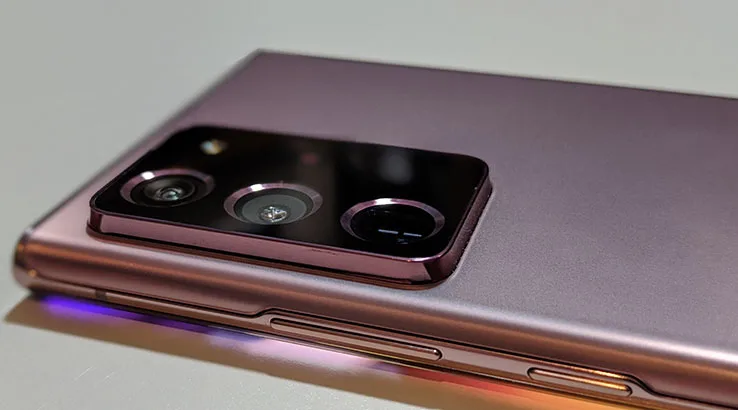
If there's an area where premium phones are meant to stand out, it's in the quality of the cameras that they ship with. That's a proposition that's come under an increasing challenge as we've seen so many mid-range phones offer up cameras that are good enough for most people's use.
The Samsung Galaxy Note20 Ultra 5G more or less borrows the camera recipe from the Samsung Galaxy S20 Ultra, with a primary 108MP f/1.8 sensor paired up with a 12MP f/3.0 5x Optical Zoom periscope sensor and 12MP ultra wide 120º f/2.2 sensor to finish out the trio. There's also a laser autofocus lens for improved depth perception. There's some slight tweaking to the S20 Ultra formula there, and as has so often been the case in years gone past, it leads to a camera that's just marginally better than its predecessor in most situations.
Naturally, straight up normal daylight photography is well taken care of thanks to that 108MP lens. You can shoot at 108MP all out if you choose, and every once in a while the Samsung Galaxy Note20 Ultra 5G will suggest you do so, but for the most part it uses pixel binning to deliver 12MP shots in standard 3:4 ratio.


You absolutely should expect that, because a simple mid-range camera can shoot well under ideal conditions. There's a couple of areas where the Samsung Galaxy Note20 Ultra 5G does stand out from the pack.
Like the Samsung Galaxy S20 Ultra 5G before it, the Samsung Galaxy Note20 Ultra 5G features "Single Take" mode, where the phone fires off all of its cameras at once around a subject of your choice, using AI to pick out video angles, still settings and filters before presenting you with a range of clips and shots of your chosen subject.
When I reviewed the S20 Ultra, I felt it tended far too much towards video over stills, but Samsung seems to have tweaked this somewhat, delivering a more balanced take between photos and videos. I'd still like to have the option to set an absolute ratio or tell it just to take this many of each type of shot, but it's certainly an easy way to take eye-catching photos if you're not into self-tweaking shots.

Then there's the question of zoom quality, with the Samsung Galaxy Note20 Ultra 5G picking up the "Space Zoom" feature of the S20 Ultra. Only not quite to the same extent. Where the S20 Ultra ran its digital AI-assisted zoom all the way up to 100x, the Samsung Galaxy Note20 Ultra 5G taps out at just 50x Space Zoom.
Honestly, 100x Space Zoom shots are rubbish, and I was keen to see if dialling the ambition down a little would improve matters to any appreciable extent. To do that, I headed to a nearby lookout in order to take advantage of every shot mode from ultrawide all the way to 50x Space Zoom.
Here's the lookout view using the ultrawide 12MP lens:

Switching to the 108MP primary lens crops in a little visually, but it's still a good representative shot:

At 5x zoom, still staying within the optical range of the Galaxy Note20 Ultra 5G, it's still clean, and you get more of the powerlines across the valley. No, that's not pretty in a shot sense, but it gives us something specific and clear to zoom in on:

Even at 10x Zoom it's decent, especially considering this was taken handheld, not on a tripod:

At 20x zoom, the cracks are really starting to show:
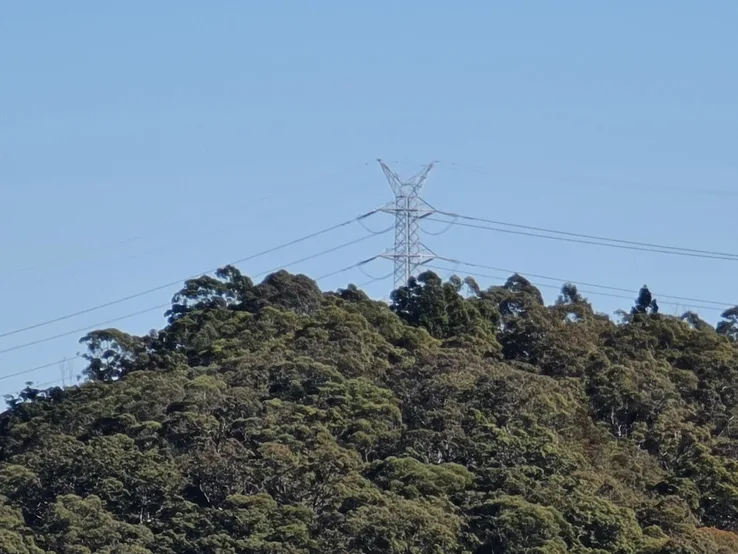
And at 50x zoom… oh dear:
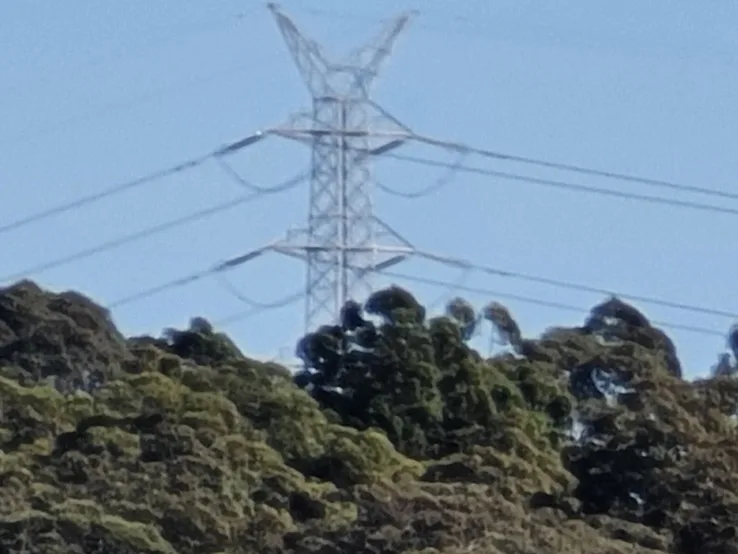
You could probably draw something more aesthetically pleasing and accurate than that mess with the S-Pen. It does still leave the Galaxy Note20 Ultra 5G with a great 10x zoom capability, but it's not generally going to be worth pushing it any further.
The other area where premium phones should prevail is in low light capability, although we have seen some challenges there from the mid-range, most notably Google's ultra-affordable Google Pixel 4a.
To test out low light capability, I headed to the same lookout late one night to see how well a range of premium phone cameras would compare against the Samsung Galaxy Note20 Ultra 5G. My test group comprised the Apple iPhone 11 Pro Max, Google Pixel 4XL, Samsung Galaxy Note20 and Huawei P30 Pro. Huawei has better cameras in market right now, but they're attached to the P40 Pro and P40 Pro+, neither of which I had access to at the time of shooting.
Apple's low light performance hasn't been stellar of late, and that was definitely the case for the iPhone 11 Pro Max, which delivered a very dark scene with a lot of noise:
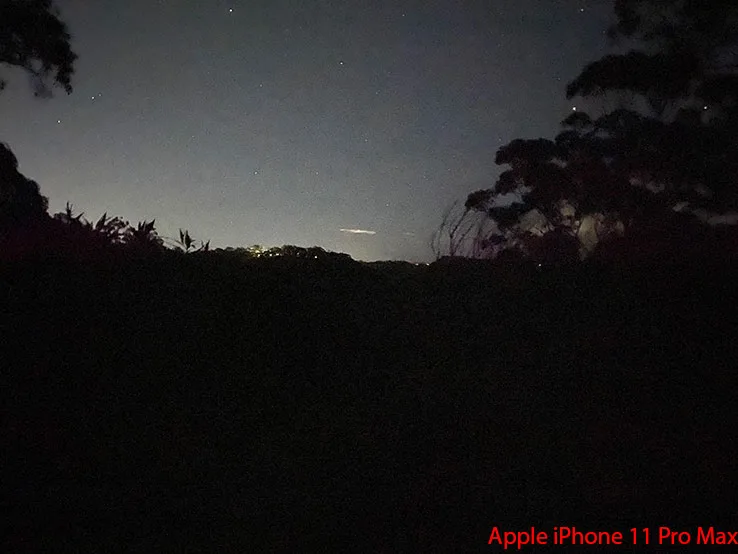
Google's Pixel 4XL makes a more aesthetically pleasing shot than the iPhone, but it struggled to grab any tree detail:
![]()
It's a very similar story for the Samsung Galaxy Note20, which runs with a primary sensor with a much lower megapixel count than the Galaxy Note20 Ultra 5G, although it swaps artificial blue night sky for a more realistic dark tone:
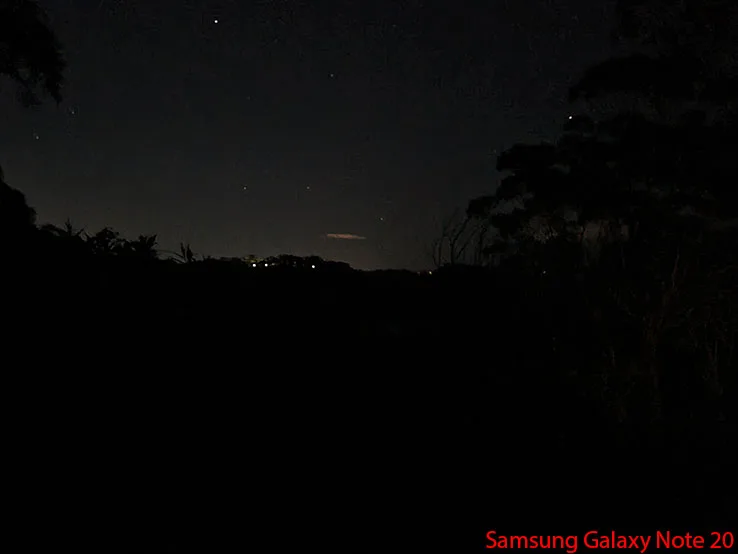
The Galaxy Note20 Ultra 5G captures a lot of detail, albeit with a fair amount of predictable noise as well. The point here is to check light capture, not get specifically "great" photos:
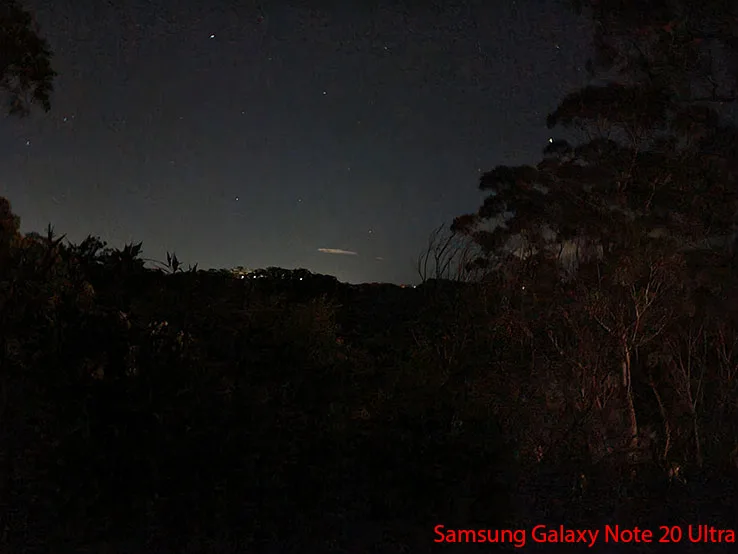
The Huawei P30 Pro still leads the pack on this score, capturing light and detail, including sharper stars than the rest in its night mode, although its regular shot mode still does a great quick capture too:
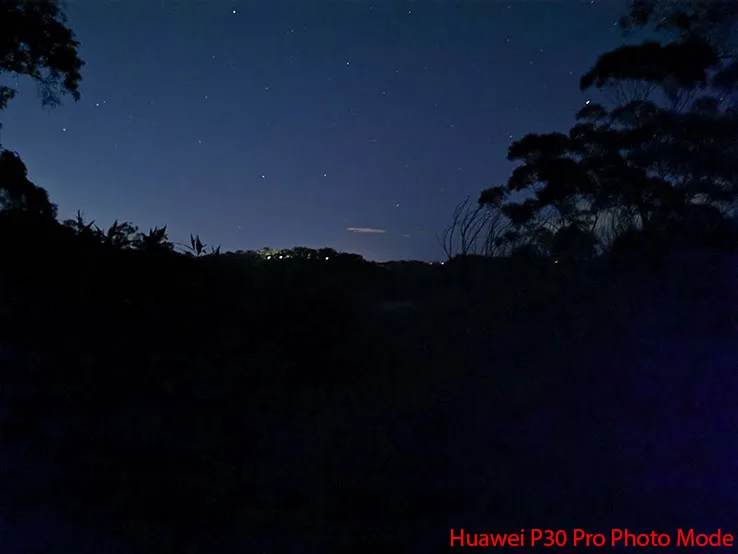
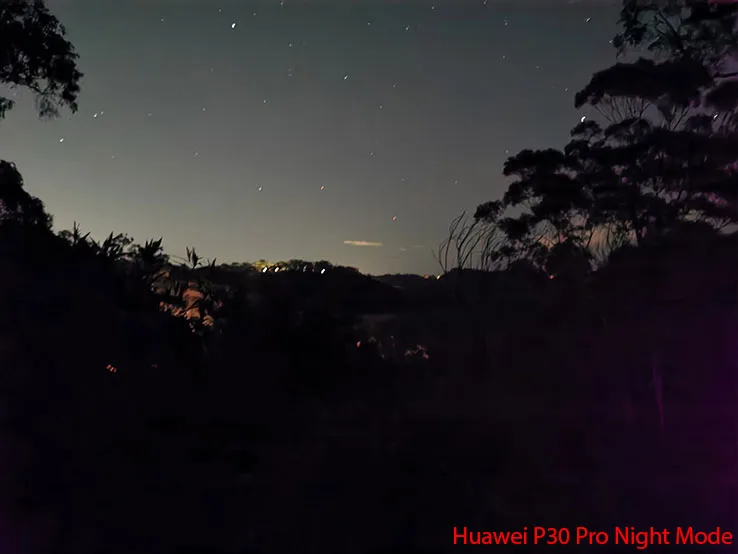
Given Huawei's crumbling Google support, it's a tougher phone to recommend every day, even if its camera is superb. That puts the Samsung Galaxy Note20 Ultra 5G in a great position when it comes to low light shooting, because it's a full Google phone with a lot of scope for low light photography, along with plenty of features that will appeal to both pro and more casual photographers alike.
On the video front, the Samsung Galaxy Note20 Ultra 5G shoots at up to 8K quality, although that's pretty much overkill unless you've invested in an 8K display to view it on. Video quality was exceptionally good in most lighting situations, and even microphone support was decent within the limits of a smartphone microphone array.
Samsung Galaxy Note20 Ultra 5G Sample Photos






Performance
Performance
- Exynos 990 plus 12GB RAM provides plenty of power
- S-Pen remains best in class… that consists of Note phones
- Wireless DeX could be great if your TV supports it
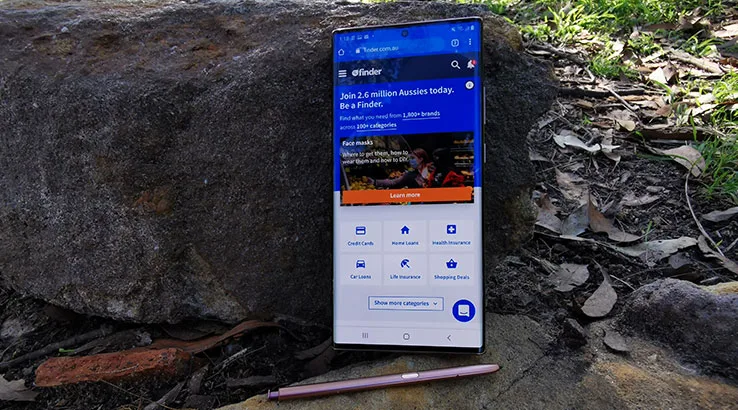
The Galaxy Note20 Ultra 5G is actually two phones in an international sense. There's the model that ships with Qualcomm's Snapdragon 865+ silicon on board, and then there's the model that will sell in Australia, running on Samsung's own in-house Exynos 990 silicon.
Typically Qualcomm's chips tend to run a little faster than Exynos models, although there can be a price paid there in terms of battery life. Either way, with the exception of the Galaxy Fold, Samsung flagships have for years sold officially in their Exynos guise only, and that's the model of the Galaxy Note20 Ultra 5G that I've tested with.
If you do opt for the 4G-only model of the Galaxy Note20 Ultra, you get a model with 8GB of onboard RAM, while the 5G models all ship with 12GB of internal RAM. 4G models ship with 256GB of internal storage, expandable via MicroSD, while the 5G models start at 256GB with a 512GB model also available.
So how does that recipe stack up compared to the best flagship phones you can buy? The Galaxy Note20 Ultra 5G compares well with its Android brethren, but it's interesting to see how it stacks up against the more affordable Galaxy Note20 especially. Here's how it compares using Geekbench 5's CPU test:
Apple's A13 Bionic as found in the iPhone 11 Pro Max continues to wipe the floor with any Android phone, and the Find X2 Pro's use of the Snapdragon 865+ gives it an edge over the Exynos phones, although that's a distinction that might vanish with an international model of the Galaxy Note20 Ultra 5G. Still, this is a highly capable handset, and the story is much the same on the 3D graphics front. Here's how the Galaxy Note20 Ultra 5G compares using 3DMark's Slingshot Extreme benchmark:
In day to day usage I really didn't hit an application that gave the Galaxy Note20 Ultra 5G any trouble, but that's to be expected in flagship 2020 handsets, and even many mid-range models too.
The Galaxy Note20 Ultra 5G is an Android 10 phone with Samsung's OneUI 2.5 layered on top. It's a necessary compromise for features like the S-Pen actions, as well as a number of Samsung-specific integrations that you'll either love or ignore completely, depending on your preferences around "clean" Android UIs.
The other selling factor for Note phones has been the included S-Pen stylus. While other manufacturers have dabbled in included stylus software, Samsung stands alone as having really committed to the concept, and it shows in just how slickly the S-Pen works in the Galaxy Note20 Ultra 5G. Pop it out of the body of the phone and the contextually appropriate actions pop up on screen.
Samsung has refined its own Notes app into a more functionally useful bit of software when used in conjunction with the S-Pen, and the improved refresh rate on the Galaxy Note20 Ultra 5G should also give it considerably better latency for each pen stroke. That's a detail you're more likely to notice if you have better artistic ability than me, however.

See, I told you.
The Note series has long had its positioning tied into being productivity devices, and in recent years that's meant a focus on Samsung's "DeX" desktop environment via cabled or dock connection. With the Note20 DeX goes wireless, allowing for miracast-compatible TVs to gain DeX-terity, although you can still opt to use it in a wired configuration if that's your preference. My own TV set lacked the necessary capability to work that way sadly, although wired DeX still works nicely if that's your preference.
Battery life
Battery life
- 4,500mAh battery takes a real hit at 120Hz
- Fast wired and wireless charging
- Wireless power share is present but not that useful
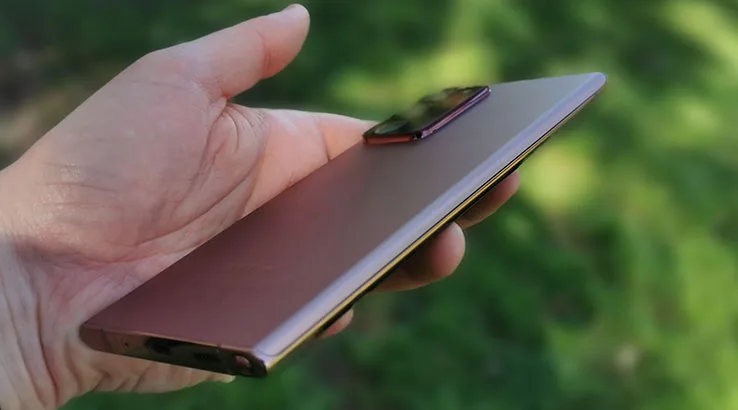
Samsung is far removed from the debacle that was the Samsung Galaxy Note 7 and its incendiary batteries of doom, but it's still somewhat cautious when it comes to battery inclusions on Note phones. That's the only logical conclusion I can draw given that the Galaxy Note20 Ultra 5G is essentially the same size as the Galaxy S20 Ultra 5G, but ships with a battery that's 500mAh smaller at 4,500mAh.
Still, that's a decent sized battery for any phone, but it has to be measured against both the larger size of the Galaxy Note20 Ultra 5G and its 120Hz refresh rate. When even the phone maker tells you that using the best refresh rate is going to cost you in battery life, you have to take notice.
To test that and gain a comparative picture of performance, I ran our standard battery test on the Galaxy Note20 Ultra 5G twice. The test involves setting screen brightness to maximum, volume to moderate and streaming a 1,080p YouTube video for an hour from 100% battery capacity. Setting the resolution to the same level but switching between forced 60Hz and "dynamic" mode where it should kick into 120Hz mode should give a picture of likely extra battery draw.
Battery usage can vary based on usage of course, but phones that can keep above a 90% battery level are typically good for multi-day battery usage.
Here's how the Galaxy Note20 Ultra 5G compared against a range of current flagships:
With 120Hz capacity enabled, the Galaxy Note20 Ultra 5G falls short of where I'd want a flagship phone to sit, although its 60Hz performance is fair for its class and battery capacity. While that test is somewhat artificial, it's one that was mirrored almost exactly in more anecdotal testing. If I left it in dynamic mode, it was often puttering out of power before the end of a day, whereas in 60Hz mode it would last through until I wanted to sleep without too much difficulty.
It is at least easy enough to charge up when it's running low on power, with up to 25W USB C charging or 15W wireless charging available. It wasn't clear from my review sample, which carried an international plug rather than an Australian one, whether you'd get a 25W charger in the box, however. Samsung's claim is that the Galaxy Note20 Ultra 5G can grab more than 50% of its charge back in around 30 minutes at full speed charging.
The Galaxy Note20 Ultra 5G also supports reverse wireless charging for Qi devices, a feature that Samsung calls "Wireless powershare". It's still something of a gimmick, because it's very slow wireless charging and mostly only useful for smaller devices like Samsung's new Galaxy Buds Live headphones.
Should you buy the Samsung Galaxy Note20 Ultra 5G?
- Buy it if you want the biggest screen and sharpest cameras on a Samsung flagship to date.
- Don't buy it if you just want the S-Pen – the Note20 is undeniably better value.
The Galaxy Note20 Ultra 5G is Samsung's current absolute flagship, but it carries with that a true flagship price point. In 2020, that's arguably a price that any phone will have to work extra hard to justify, because all of our budgets are that bit tighter, and there's a lot of pressure from some really excellent mid-range phones.
The Galaxy Note20 Ultra 5G has an additional challenger in the form of the Galaxy Note20 5G, a phone that matches it step for step in performance terms. It's not quite as sharp in the camera space, but it's a distinction that most users will never notice, making it our pick for the best Note phone in overall value terms right now.
Where does that leave the Galaxy Note20 Ultra 5G? It's still an excellent phone, and if your tastes run to really large displays and the best possible cameras Samsung can make, it may well be your best choice. Just slap a case on it pronto to deal with that annoying camera bump.
Pricing and availability
Compare Samsung Galaxy Note20 Ultra 5G plans
Specifications
Display
Camera
Physical Dimensions
Connectivity
Power, storage and battery
Device features
Images: Alex Kidman
More Finder reviews
- Apple HomePod 2nd Gen review: Yes, it’s better
- Creality Ender-3 S1 Pro Review: Plenty of creative potential, but you’ll need patience too
- Apple Mac Mini M2 Pro review: A tale of two computers
- Apple MacBook Pro M2 Max 16-inch review: Next-level power
- HTC Vive XR Elite: Is this the perfect mix of Flow and Pro?
